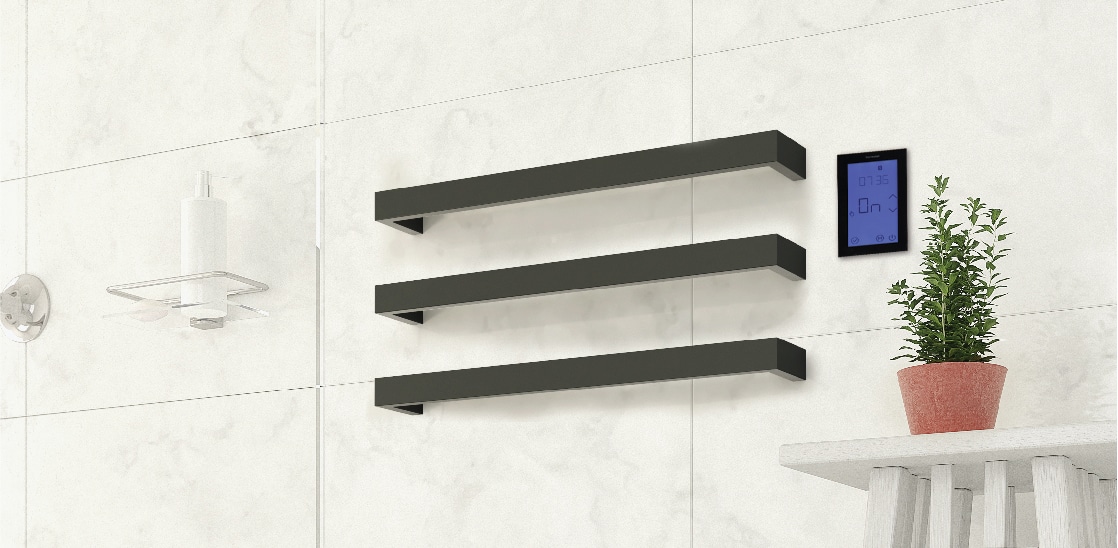
In the world of Heated Towel Rails, one of the common questions that we get asked is how do I control my Heated Towel Rail. This comes from people who are considering adding a Heated Towel Rail in their bathroom or from those who already have a Heated Towel Rail, so in this article, we will address why you should control your Heated Towel Rail and some options for doing so based on both instances. Lastly, we will wrap up by looking at if controlling your Heated Towel Rail is worth it.
Do I need to control my Heated Towel Rail?
To begin we want to cover in broad terms why you need to control your Heated Towel Rail. Firstly, as an electrical appliance, it is an electrical regulation that at a minimum it has an isolating switch so that you can turn the towel rail on or off. This means that if something was to happen to the rail to make it electrically unsafe you could turn the rail off in the room.
The second reason we would highly recommend that you consider, as to why you need to control your Heated Towel Rail is so that you don’t leave the rail running all the time or forget to turn it on in the first place. An electric Heated Towel Rail builds up additional heat under the towel so it is recommended that the rail isn’t running constantly to allow for the build-up of heat to dissipate.
And when it comes to forgetting to turn the rail on, well no one wants to step out of their shower to find a cold damp towel, especially when you have a rail to prevent just this.
Lastly, and linking to the above point, the use of a timer will allow you to set when your Heated Towel Rail is on or off, therefore reducing your ongoing running costs as opposed to having the rail running constantly. That combined with the fact that you can just set and forget and find a warm dry towel waiting for you every time you need it, is why you need a timer.
How do I control my Heated Towel Rail – Hard Wire Applications
For a hardwired application, you have several different options.
Firstly there is just the standard on/off switch as we mentioned, with no programming or potential running cost savings so effectively the bare minimum for control.
The next option to consider is the ET12C timer. The ET12C is a repeat timing device, it works on doing a repeat schedule for the same number of hours morning and evening all seven days of the week. Of course, you have the ability to set the start time based on your schedule.
For instance, you could set the timer to come on at 6 am for four hours, the timer would also come on at 6 pm for four hours, all seven days of the week. The ET12C is simple to set up and has a cost-effective timer that is hidden in the wall, all operated by the switch plate.
Find out more about the ET12C here.
The next option is the fully programable touchscreen timer. This timer is available in portrait white TRTS, portrait black TRTSB and horizontal white TRTSL.
The sleek glass unit offers full programming capability for you to control when your towel rail is on or off with two different heating periods per day. The timer also offers the ability to override the schedule if required, for instance, you if want to turn your rail on in the middle of the day to dry some clothes if it is raining outside.
The fully programable timer gives you ultimate control at an affordable price point. To learn more about the programable timers click here.
Lastly, if you have Underfloor Heating & a Heated Towel Rail the dual controller is the perfect pick for controlling your rail. The dual controller features two independent relays that can be operated on one unit, giving you the ability to set up two different schedules without needing two controllers in one room.
Find out more about the dual controls for use with controlling your Heated Towel Rail here.
How do I control my Heated Towel Rail – Plug-in applications
The options for controlling your Heated Towel Rail if it is an exposed plug in application are more limited. Again you have the option of the switch, or in this case the switch on the PowerPoint, however, there are two other ways to control your rail.
Firstly, you could use the Eco Timer and wire it into the back of the PowerPoint. This would allow you to use the switch on the PowerPoint to set the number of hours the rail is running and what time of day it is running. Remember that if you wire the Ecotimer into a double PowerPoint, both plug sockets will be operating through the timer, it may be best to swap it to a single power point to avoid any confusion.
The other option is to use a plug-in dial timer. These timers are commonly available at an electrics or hardware store and allow you to set when the rail comes on and the number of hours the rail is running for without needing an electrician.
Is a timer worth it?
We have looked at the different types of ways to control your Heated Towel Rail so the ultimate question is, is it worth it?
As the minimum option, you are going to have a switch which we will assume means the rail is left running constantly. We are going to run an analysis to see what savings a timer will bring as opposed to a switch based on our popular SR44M 600×800 ladder rail.
The SR44M uses 80 watts of electricity an hour so in 24 hours it would use 1920 watts.
The SR44M running on a timer for two periods of three hours a day, a total of six hours at 80 watts an hour would be 480 watts.
This means the timer saves you 1440 watts of electricity a day.
Let’s work out that saving in dollars based on an average electricity tariff of 30c/KW.
The timer is saving 1.44KW (1000 watts is a KW) which at a rate of 30c/KW will save you $0.43 a day. Work that out over a year and the timer saves you $157.68 in the running costs of your Heated Towel Rail.
In the case of the Eco timer the savings have paid off the timer in less than a year and the touchscreen timer would be paid off in a year and a half.
Summary
In summary, the case for having a programable way to control your Heated Towel Rail is clear. Not only does it save you running costs with a relative short payoff, but it also means you can always ensure that your rail is warm and dry when you need it.
No more cold damp towels and no unnecessary expenditure on unneeded running costs.

Find the perfect Digital Timer for your Heated Towel Rail
|

Question not answered yet? We are here to help
|
